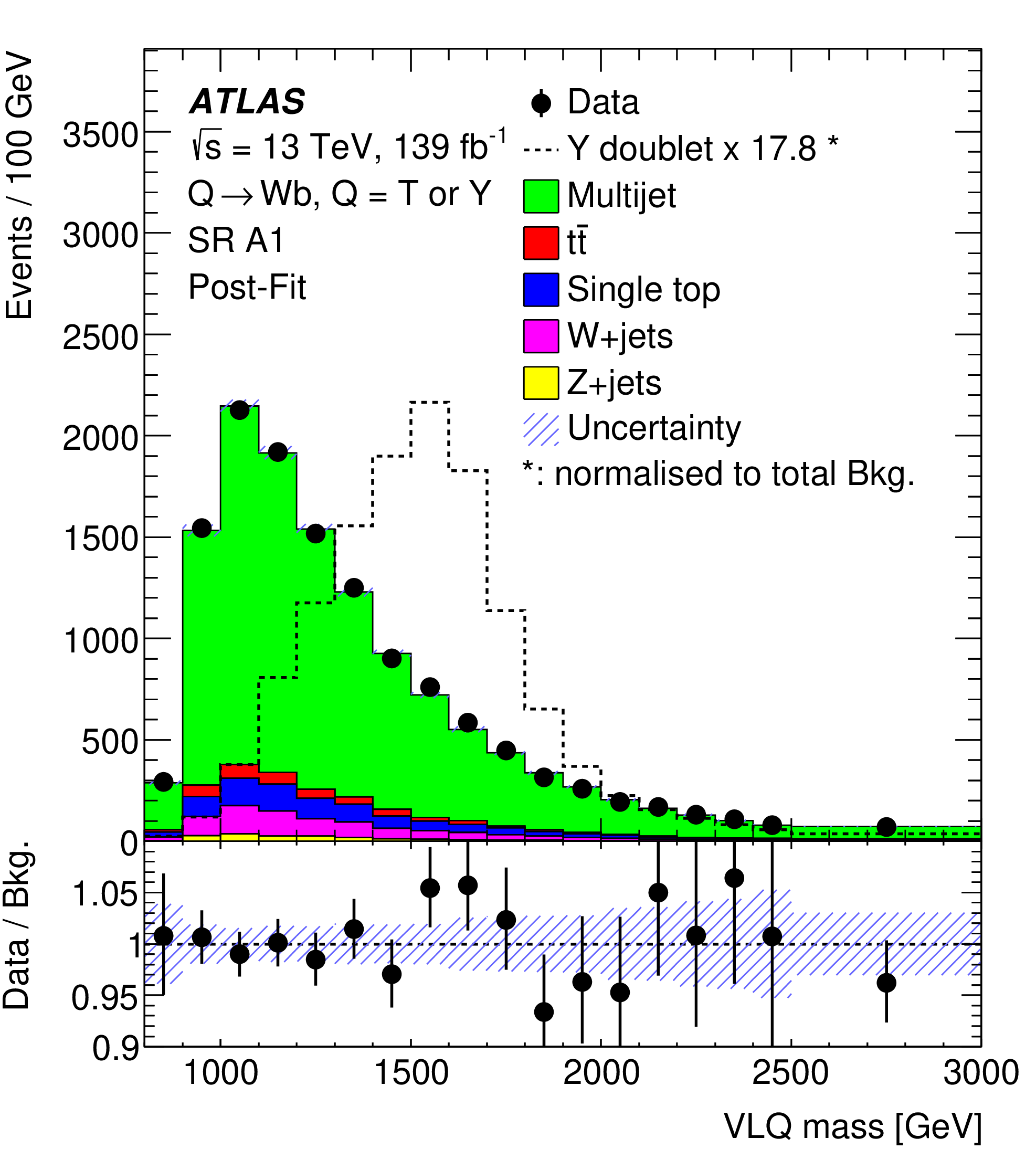Oct 3rd, 2024
ATLAS Collab.
This paper reports a search for a light CP-odd scalar resonance with a mass of 20 GeV to 90 GeV in 13 TeV proton-proton collision data with an integrated luminosity of 140 fb−1 collected with the ATLAS detector at the Large Hadron Collider. The analysis assumes the resonance is produced via gluon-gluon fusion and decays exclusively into a τ+τ− pair which decays into a fully leptonic μ+νμντe−νeντ or e+νeντμ−νμντ final state. No significant excess of events above the predicted Standard Model background is observed. The results are interpreted within a flavour-aligned two-Higgs-doublet model, and a model-independent cross-section interpretation is also given. Upper limits at 95% confidence level between 3.0 pb and 68 pb are set on the cross-section for producing a CP-odd Higgs boson that decays into a τ+τ− pair
ATLAS Collab.


ATLAS Collab.


MMC from arXiv:1012.4686
ATLAS Collab.


ATLAS Collab.
A search for T and Y vector-like quarks produced in proton-proton collisions at a centre-of-mass energy of 13TeV and decaying into Wb in the fully hadronic final state is presented. The search uses 139 fb−1 of data collected by the ATLAS detector at the LHC from 2015 to 2018. The final state is characterised by a hadronically decaying W boson with large Lorentz boost and a b-tagged jet, which are used to reconstruct the invariant mass of the vector-like quark candidate. The main background is QCD multijet production, which is estimated using a data-driven method. Upon finding no significant excess in data, mass limits at 95% confidence level are obtained as a function of the global coupling parameter, κ. The observed lower limits on the masses of Y quarks with κ=0.5 and κ=0.7 are 2.0 TeV and 2.4 TeV, respectively. For T quarks, the observed mass limits are 1.4 TeV for κ=0.5 and 1.9 TeV for κ=0.7.
ATLAS Collab.


Prefit

Postfit

ATLAS Collab.



SuperK collab.
A search for proton decay into e+/μ+ and a η meson has been performed using data from a 0.373 Mton⋅year exposure (6050.3 live days) of Super-Kamiokande. Compared to previous searches this work introduces an improved model of the intranuclear η interaction cross section, resulting in a factor of two reduction in uncertainties from this source and ∼10% increase in signal efficiency. No significant data excess was found above the expected number of atmospheric neutrino background events resulting in no indication of proton decay into either mode. Lower limits on the proton partial lifetime of 1.4×1034 years for p→e+η and 7.3×1033 years for p→μ+η at the 90% C.L. were set. These limits are around 1.5 times longer than our previous study and are the most stringent to date.
CMS-GEN-22-001
We present an analysis based on models of the intrinsic transverse momentum of partons in nucleons by studying the dilepton transverse momentum in Drell-Yan events. Using parameter tuning in event generators and existing data from fixed-target experiments, from the Tevatron, and from the LHC, our investigation spans three orders of magnitude in center-of-mass energy and two orders of magnitude in dilepton invariant mass. The results show an energy-scaling behavior of the intrinsic transverse momentum parameters, independent of the dilepton invariant mass at a given center-of-mass energy.
Wei-Shu Hou, Mohamed Krab
We suggest searching for charged Higgs bosons via c b → H+ → W+H → ℓ+ ν t c at the Large Hadron Collider (LHC). In the general two Higgs doublet model (G2HDM) that possesses flavor changing neutral Higgs (FCNH) couplings, the process is induced by the FCNH top-charm coupling ρtc without Cabibbo-Kobayashi-Maskawa (CKM) suppression, and may occur if mH+ > mW++mH , giving rise to the same sign dilepton signal. We perform a signal-to-background analysis at 14 TeV LHC and find that discovery might be possible with LHC Run 2 data already at hand.
ATLAS Collab.
This paper presents a search for supersymmetric particles in models with highly compressed mass spectra, in events consistent with being produced through vector boson fusion. The search uses 140 fb−1 of proton-proton collision data at √s=13 TeV collected by the ATLAS experiment at the Large Hadron Collider. Events containing at least two jets with a large gap in pseudorapidity, large missing transverse momentum, and no reconstructed leptons are selected. A boosted decision tree is used to separate events consistent with the production of supersymmetric particles from those due to Standard Model backgrounds. The data are found to be consistent with Standard Model predictions. The results are interpreted using simplified models of R-parity-conserving supersymmetry in which the lightest supersymmetric partner is a bino-like neutralino with a mass similar to that of the lightest chargino and second-to-lightest neutralino, both of which are wino-like. Lower limits at 95% confidence level on the masses of next-to-lightest supersymmetric partners in this simplified model are established at 117 GeV when the lightest supersymmetric partners are within 1 GeV in mass
ATLAS Collab.



ATLAS Collab.

SR2j

SR≥3j

ATLAS Collab.



Q. Sha et al
Analysis of data from particle physics experiments traditionally sacrifices some sensitivity to new particles for the sake of practical computability, effectively ignoring some potentially striking signatures. However, recent advances in ML-based tracking allow for new inroads into previously inaccessible territory, such as reconstruction of tracks which do not follow helical trajectories. This paper presents a demonstration of the capacity of ML-based tracking to reconstruct the oscillating trajectories of quirks. The technique used is not specific to quirks, and opens the door to a program of searching for many kinds of non-standard tracks.